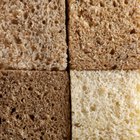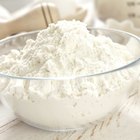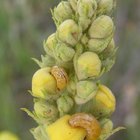Weevils are a pest to farmers and non-farmers. They destroy crops, kill garden plants and infest susceptible food in the home. Home infestations usually occur after infested grain products have been bought and brought home. Weevil contamination may go unnoticed for several weeks until suddenly, the food seems overrun by small, live, wriggling bugs.
The Facts
There are between 40,000 to 60,000 species of weevils--which are a type of beetle--in the world. Most weevils are smaller than 1 inch long; many are smaller than 1/2 inch. Unfortunately, their small size doesn’t prevent them from destroying entire cupboards full of food or a field of grain. One female weevil produces around 400 eggs in her short lifetime. It does not take long for a few weevils to become many weevils. Weevils that commonly infest homes, such as granary weevils and rice weevils, lay their eggs inside kernels of grain, which provides food for the growing larvae. Warm, humid temperatures provide ideal conditions for weevil infestations.
Risk Factors
Flour, rice, other grains, sugar and seeds are all susceptible to weevil infestations if improperly stored. It only takes one infested bag of flour or rice to contaminate an entire cupboard of food in a short time. Grains and other food susceptible to weevils should be placed in the freezer for at least 72 hours to kill any larvae or adult weevil. After freezing, these products should be placed in airtight containers to prevent further infestation.
Weevils such as the Rice weevil, which loves all grains, and the Boll weevil, an enemy to cotton crops, can decimate entire fields of crops if left unchecked.
Identification
The weevils most Americans are familiar with are the weevils that infest flour, grains, or seeds in the pantry. These are called flour weevils, rice weevils and granary weevils. All weevils have a small body with six legs and a pair of distinct antennae. The antennae may look like an extra pair of legs (though smaller). Weevils come in a wide variety of solid colors and patterns. Flour weevils are usually dark red. Rice weevils and granary weevils are usually rust-colored (as adults) or black and have a long nose.
Weevil larvae are usually not noticed in white flour because they are small and can be similar in color to the flour. Common signs of weevil infestation are active, visible bugs, pupae casings or webbing in flour, sugar, rice or other grain products.
Time Frame
Weevils mature from larvae to adult stage in less than one month--usually only 3 weeks. Adult weevils can live up to half a year in warm, humid climates (or warm homes).
Significance
Weevils in the home are not usually a health hazard and, thankfully, weevils do not bite. However, infestations are unpleasant and can be costly. The safest methods of controlling weevils in the home are getting rid of contaminated products and/or freezing flour and grain products promptly upon bringing them home from the store. Infestations may become so bad that you have to use insecticides. Take safety precautions if you do this, and use pheromone traps or other safe methods for the kitchen.
Related Articles

Bugs That Get Into Pantry & Food

What Types of Insects Eat Leather?

Does Flour Get Old or Go Bad?

How to Store Flours & Grains Without ...

How to Identify Grain Beetles
How Long Can Flour Be Stored in Mylar ...

Does Flour Expire?

Can You Use Musty Smelling Flour?

How Do You Keep Bugs Out of Baking ...

Worms That Eat Clothes

How to Prevent Moths in Long-Term ...

Does Flour Spoil?
Methods of Long-Term Food Storage for ...

Can I Freeze Wheat Berries?

Do the Same Types of Mold Grow on All ...

Proper Handling and Storage of Rice

How to Store Flour

Does it Help to Keep Flour in the ...

What Foods Attract Maggots?

Can Bugs Grow in Spices Such As Paprika?